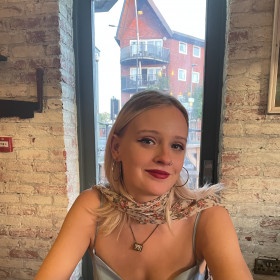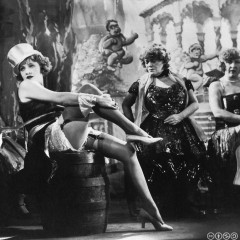The Golden Age of Hollywood would not have been as golden without Marlene Dietrich. A German film star whose career peaked in the 1930s, she was popular with cinemagoers not only for her acting abilities but for what she represented. Most photographs depict her in a top hat and tails, balancing a cigarette in her mouth, subverting ideas of how a woman was supposed to look while always oozing outrageous glamour and sensuality. Dietrich also unashamedly rejected the heteronormative society she lived in and was openly bisexual.
For me, what makes her so iconic is her longevity. She didn’t just have her time in the sun during her youth, but continued acting and performing well into her old age. Unafraid to promote her sexuality, she proved she was in control of her image. Dietrich constantly subverted feminine expectations, and people loved her for it.
Born in 1901 in Berlin, Dietrich enjoyed a fairly middle-class upbringing. Despite this, she had to fund her career by working in a factory whilst performing in the cabaret clubs of Berlin. By 1923 she was married to Rudolf Sieber. The two had an open relationship, both parties had affairs, and both seemed to be fine with this – at least on the surface. They remained married until Sieber died in 1976.
Dietrich appeared in silent films in Germany but was never a massive star. That was until 1930 when director Josef von Sternberg wanted Dietrich to play cabaret performer Lola Lola in his film, ‘The Blue Angel’. Dietrich and von Sternberg would form a collaborative relationship that allowed Dietrich’s career to skyrocket.
From him, she learnt camera techniques, lighting and makeup that gave Dietrich that iconic look that has been imitated decades after. In any picture of her, you are instantly confronted by her challenging eyes and sharp cheekbones – reminding you of her power. She was an active participant in carving her image, something many women struggled to do in the film industry at this time.
Dietrich’s image was fully realised in the film ‘Morocco’. She wore a full suit, top hat, tuxedo and tails, kissing a woman on the lips – not a common occurrence in 1930s cinema. She was the antithesis of Hollywood, yet they wanted her. That icy stoicism European stars seemed to bring was desirable for Hollywood. Before Dietrich, with Greta Garbo, and afterwards, with Ingrid Bergman. Leaving her family behind, she moved there and signed a contract with Paramount. Eventually, she became a US citizen in 1939.
The Second World War was an important aspect of how people perceived Dietrich. Apparently, she was offered highly paid contracts from the Nazis to work for them, even offering her a great deal of creative freedom in her projects. It seems odd that fascists would be so entranced by a bisexual, overtly sexual woman who frequently dressed masculine.
Evidence of her mystique is further shown through the rumour that Hitler even asked her to be his mistress. Naturally, the anti-fascist Dietrich declined and became a crucial part of the Allies’ war effort. Dietrich also worked tirelessly to help Jews escape from Germany and donated her salary towards helping refugees.
After the war, people have suggested that Dietrich’s career started to dry up. I disagree. Hollywood notoriously dropped women once their youthful beauty had faded, always moving on to the next young woman they could exploit. Dietrich continued touring and performing, in cabaret notably, around the world until she was in her 70s. She wasn’t playing the little old lady on stage; she danced and embraced her sexuality without considering her age. However, she eventually withdrew from the limelight after her husbands’ death and was rarely seen outside her Parisian apartment. She died in 1992.
Recently there has been an emphasis on her sexuality. There are claims she had affairs with a great deal of famous women, including Greta Garbo, which seems like a match made in cinematic heaven. Dietrich was also part of what was known as the ‘Sewing Club’ during Hollywood’s Golden Age. Ironically named, this was an underground society of lesbian and bisexual film actresses who socialised with one another. As there has been a greater push to voice LGBTQ+ history recently, it is great to see this aspect of Dietrich’s life being looked at more.
Perhaps the most dominant thing about Dietrich was how she expressed herself through her fashion. It is what I certainly remember her for, and it contributes to her striking, powerful persona. However, she apparently did not care about fashion for someone so well dressed. Dietrich curated the way she dressed, maybe to boost her career, maybe to tease people, but certainly to make a political statement. Whether it was the tuxedo as seen in ‘Morocco’ or other outfits, she always seemed to be challenging traditional conceptions of femininity.
Today Dietrich is still a muse for many. You look at the style of pop stars such as Madonna or Lady Gaga, and you see Dietrich. The cover of Queen’s album ‘Queen II’ is directly inspired by an image of Dietrich in the ‘Shanghai Express’. Even Bjork’s swan dress from the Oscars is just a shorter version of one she wore. A lot of drag artists and fashion designers use Dietrich’s image to curate their style, and when you look back at pictures of her, it's easy to see why.
Dietrich has been adopted as an icon for anyone who does not fit into the narrow norm. I do wonder who the real Marlene Dietrich was under this mesmerising illusion. She herself said that she curates an image of herself, so how much of herself she really gave to the cameras is debatable. However, the fact that she still has us guessing nearly a century on shows just how powerful she remains.








0 Comments